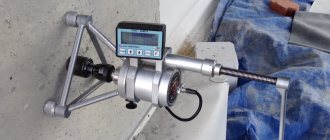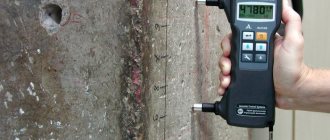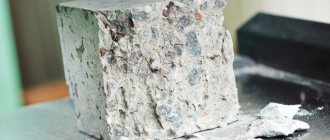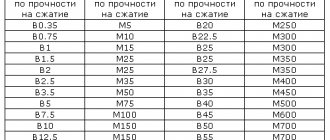The first method for testing the hardness of raw materials was developed back in the 19th century, when cuts were made on materials with sharp objects or sawed.
Today it is very convenient to use a sclerometer to measure the hardness of building materials, for example, concrete.
Features of the device for measuring the strength of concrete using a non-destructive method
Initially, this word “sclerometer” is translated as “hardness tester” - a device for determining the hardness of materials. The technique consists of scratching a material : this method has been used in science for 300 years.
In the construction industry, this device is most often used for diagnosing concrete. Hardness measurement is carried out using a standardized diamond head, which is dragged through the concrete. Indicators are determined by finding out the level of pressure that is necessary to create a scratch.
The operating principle is as follows:
- the instrument is applied to the surface under study using a striking mechanism;
- press the device sharply;
- indicators appear on the scale;
- different types of devices operate differently.
The main essence of the work is elastic rebound . The impact force is normalized by the energy of the striker and is measured in conventional units. The operating principle of this electronic type tool is standardized by GOST 22690-88.
Features of the proposed GGP devices
Hand-held instruments of the IPS series, offered by PromGroupPribor at the most attractive price, are equipped with everything to quickly obtain reliable, high-precision data. The installation includes a system for entering calibration correction coefficients (specified in Appendix Z GOST 22690), group switches for the measurement unit, and an algorithm for neutralizing erroneous values.
Each hand-held meter is equipped with a data storage and intermediate processing unit. During testing, averaging is immediately carried out, weeding out clearly abnormal indicators, and prompt rejection of the results. The calculated value of strength and concrete class is displayed on a convenient display and recorded in the device’s memory.
Another convenience of IPS class devices is the ability to transfer data to a computer for subsequent analysis and application. They can be used not only as an average statistical cut and data for certification, but also participate in the modeling of various processes occurring under loads in building structures.
Purposes of application
At the moment, the term “sclerometer” means any device with which the planes under study are scratched. With their help you can check the following characteristics :
ability to resist the impact of a harder object;- ability to resist abrasion;
- the ability to restore its structure after exposure.
Sometimes this tool is also called a “concrete hardness hammer.” Scope of application: construction.
With the help of such a tool , the condition of buildings is monitored, and the strength of concrete, mortar and other composite materials that were used in the construction of structures and structures is tested.
An object is checked with a device of this type once a year.
All devices are reliable and easy to use; they help to check the required indicator in a short time. You can also use a sclerometer for your own purposes - to check the strength of concrete in a mortar used to build a house.
Compact and convenient devices
The devices for testing the quality of concrete offered by PromGroupPribor are aimed at the most efficient research of materials and structures. They do not require long and complex training of responsible personnel and allow the measurement of several indicators. Also, hand-held devices operating using the shock pulse method can be used to determine the parameters of ceramics, bricks and other building materials.
The measurement technique and methodology on which the operation of IPS-class devices is based is standardized and described in GOST 22690. Using these compact and lightweight devices, you can study the strength, elastic-plastic properties, and hardness level of concrete.
When processing the results obtained, a number of optimization algorithms are used, which allows you to immediately obtain high reliability of the research performed. Each device is equipped with a data storage system.
Varieties
In modern construction stores you can find 3 types of sclerometers for concrete: ultrasonic, electronic and mechanical. Each of them has its own characteristics.
Ultrasonic
This type of device calculates the strength of materials based on the time and speed of the emitted wave. The body is often made of plastic, and on the front side there are buttons and a display. There are 2 contacts on the side of the case.
The device runs on batteries and has the function of saving the measurements taken. The peculiarity of the ultrasonic model is that it can exchange data with a computer, is conveniently controlled, sounds the work process, automatically changes waves and is able to find defects and cracks in concrete.
Among modern models we can give examples of such devices:
- Interdevice PULSAR 2.1 Version 1;
- SKB Stroypribor UKS-MG4;
- AKS UK1401M.
Some models are capable of not only measuring the strength, but also the depth of the concrete solution. The ultrasound method used is regulated according to GOST 17624.
Review of ultrasonic units in this article.
Electronic
Electronic devices have small dimensions, which makes them convenient to use. Device :
- displays indicators taking into account temperature error;
- runs on batteries.
The error itself is small, so the device is universal - it can be used not only on concrete, but also on brickwork, composite, marble and metal surfaces.
Among the distinctive features are the ability to record measurements, the ability to transfer data to a computer, sort the measured data and change the direction of the impact.
The most interesting models:
- Control Beton Easy;
- Control Concrete Pro.
More detailed information about electronic sclerometers here.
Mechanical pistols
Mechanical devices have an elongated shape and somewhat resemble a large ballpoint pen. A striker with a spring is built inside the device. There is a scale located outside that displays the surface pressure withstand.
The range of applications for such a device is small, it has a significant error, although it is inexpensive, it is inferior in accuracy to electronic models.
The most successful examples of such tools:
- ADA SchmidtHammer 225 A00191;
- RGKSK-60.
Their feature is the ability to work at low temperatures, as well as heavy weight.
Examples of manufacturers
The Russian company SKB Stroypribor is a popular manufacturer of strength meters in the construction market. A wide range of products from the Beton Pro and ADA brands is offered.
Return to contents
Ips-mg4.03
Ips-mg4.03 is used in determining the strength parameters of heavy and fine-grained concrete, expanded clay concrete, slag pumice concrete, concrete mortars, and bricks. The operating principle is based on receiving data from a shock pulse. Taking into account the hardening conditions and age of the material, the Ips-mg4.03 meter determines:
- physical and mechanical parameters of the sample, including strength indicators, hardness, ductility;
- the amount of heterogeneity;
- low compaction zones.
Features of IPS-MG4.03:
- the ability to enter a coincidence coefficient for comparison with calibration characteristics;
- availability of sample type selection;
- option to determine concrete class;
- possibility of eliminating measurement error;
- availability of outputs for connecting to a computer;
- large memory capacity of 999 sections and 15 thousand results;
- the ability to enter calibration characteristics manually;
- adjustment of 100 settings to select the type of filler, material and age of concrete.
Return to contents
Beton Pro Control
The concrete strength meter beton pro condtrol is suitable for operational analysis on site and for laboratory monitoring of strength fluctuations, uniformity of cement composition, concrete mortars, bricks. The operating principle is based on the measurement of the shock impulse. Benefits of work:
- obtaining high-precision values;
- ease of use;
- increased impact energy;
- Impact Mechanism Automobile Plant;
- a large number of settings;
- clarity of information output;
- The result is practically not affected by the age, composition, and hardening conditions of concrete.
Beto Pro CONDTROL has 100 strength-related calibration dependencies, five impact directions, a function for assigning a characteristic to the sample under study, a memory for 5 thousand measurements with the ability to sort and reject the obtained values, an output for connecting to a computer, the option of constructing a diagram of the standard deviation and the coefficient of variation.
Return to contents
ONYX-OS
The device is used to determine the strength indicators and uniformity values of lightweight concrete and brick. Belongs to the class of electronic sclerometers. Onyx-OS has the following advantages:
- a two-parameter method for monitoring strength indicators based on shock impulse and rebound, which allows you to obtain the most accurate results;
- lightness, compactness and ergonomics;
- maximum accuracy of the measuring path.
The device implements basic calibration characteristics with the possibility of refinement based on the coincidence coefficient. It is possible to configure the required measurement parameters and sample names. Measurements are carried out taking into account the composition, conditions of hardening, carbonization and age of concrete. All measurement results, information about samples, variable coefficients, time and date of research are stored in the ONICS-OS memory. In this case, the necessary data with diagrams is quickly displayed on the backlit screen. Onyx-OS has options for auto-shutdown of the device, auto-deletion of outdated data, and determination of concrete class.
Return to contents
NOVOTEST IPSM-U T D
The ultrasonic unit produces:
- control of strength parameters of concrete, brick and composite structures;
- measuring the depth of pores, cracks, defects in concrete;
- control of density and elasticity of carbon graphite and fiberglass;
- determining the age of concrete.
A special feature is the ability to manually process the results, the absence of influence of external factors on the measurement accuracy, and an ultra-sensitive sound sensor.
Return to contents
Comparison of different equipment models
To better understand which sclerometer model is most suitable for certain purposes, it is recommended that you familiarize yourself with the most popular devices in this category.
| Model | Type | Peculiarities | pros | Minuses |
| ONIX-2.5 | Electronic |
|
| High price |
| ADA Schmidt Hammer 225 A00191 | Mechanical |
|
| No verification upon purchase |
| Interdevice PULSAR 2.2 Version 3 | Ultrasonic |
|
| High price |
| RGK SK-60 | Mechanical |
|
| Error |
| Control Beton Easy | Electronic |
|
| Accuracy 7% |
| UKS-MG4S | Ultrasonic |
|
| High price |
The table shows that the most expensive, but at the same time the most accurate and convenient to use, will be ultrasonic devices - they are often used by professionals.
What is the essence of the method?
Ultrasonic flaw detection of concrete is one of the most progressive and reliable methods for measuring the strength of concrete structures using a non-destructive technique. In practice, two basic methods of ultrasonic examination of concrete structure are used:
Deep, or through - ultrasonic waves penetrate the entire thickness of the concrete structure, and the indicators are recorded based on the speed of passage of the sound wave.
When measuring, several iterations are performed, each of which gives its own numerical values. Based on a comparison of the results after several measurements, a conclusion is issued about the homogeneity of the element.- Surface - the device is placed directly on the visible plane of a concrete or reinforced concrete structure in several places, which makes it possible to determine the presence of microcracks or heterogeneity of the material.
Indicators obtained from the results of ultrasound examination are indirect and are subsequently compared with graphical or tabular values describing the dependence of strength on the speed of passage of the sound wave for each iteration.
What types of materials is it suitable for?
The device is used for the following types of concrete laid in the frame structure of the future property:
- Heavy concrete with coarse aggregate of any class, the age of which has reached 28 days, which corresponds to the standard hardening period.
- Lightweight concrete based on cement binder with porous aggregate.
- Reinforced concrete structural members of walls, columns, pylons, floors or beams laid in a structure, regardless of the percentage of steel.
In some cases, it is permissible to use the method of ultrasonic diagnostics of concrete when the structure is at an intermediate stage of strength gain.
In such cases, the resulting indicator must be subjected to double interpolation - recalculation of the wave propagation speed into the value of the design strength, as well as reduction to the actual class, based on the results of the analysis of the hardening schedule.
Principle of operation
Sclerometers work according to the following principle :
The meter is applied with a striking mechanism to the surface under study.- Using both hands, gently press the sclerometer towards the surface until the striker strikes.
- Measurement readings appear on the scale.
- Measurements are carried out several times to eliminate errors.
In essence, the operation of the sclerometer is simple and is based on the action of spring and rebound. The instructions for each device indicate the features of working with the devices.
A detailed article on using the device is here.
Verification
Verification of sclerometers is a mandatory procedure for all companies involved in construction, as well as for those companies whose products fall within the scope of state regulation to ensure the uniformity of measurements.
When is this needed and why?
Verification of such devices is extremely important when they are used to carry out critical measurements. If the instrument model is included in the State Register of Instruments and is used in the field of GROEI, then verification will be mandatory. This is done to ensure that the measurement error does not exceed the manufacturer's specified values.
If the device has already been verified, its cost will initially be higher.
How is it carried out correctly and where?
Verification is carried out in special metrology laboratories using equipment installed for this purpose. It includes :
- visual inspection;
- testing;
- control of the rebound of the striker;
- calculation of variations in indicators and the average error.
Verification is carried out by certified specialists, and in-depth control is carried out according to the protocol. After verification is successfully completed, a certificate of the established form is issued. The manufacturer must present this certificate when selling the devices.
Possible errors and what do they depend on?
Any metrology equipment used in the field cannot provide absolutely accurate measurement results. In this regard, manufacturers establish permissible errors that do not affect the safe operation of a capital structure.
Differences depend on the following factors:
Type of sclerometer - ultrasonic and electronic devices have an extremely low error of up to 1.5% -2.0%. Mechanical instruments with a conventional analogue scale may exhibit discrepancies of 5% to 10%.- Climatic conditions and temperature and humidity conditions - most factories allow additional errors that do not exceed normal limits, up to 0.5% for every 10 °C.
As a rule, ultrasonic and electronic devices can operate in a temperature range from –10 to +40 °C.
- Type of surface and quality of concrete - in the presence of inhomogeneities and a large number of defects, the readings for each iteration may vary by 10% or more. In such cases, experts recommend not taking into account measurements that clearly stand out from the average statistical values, provided that there are no more than 10% of such zones on the surface of the structure.
In practice, sclerometers are considered one of the most accurate instruments. Most Russian ultrasonic or electronic models are included in the State Register and can be used by professional expert bodies to issue official conclusions, which are subsequently provided to various competent authorities, for example, to court.
Pros and cons of use
After the information received, we can draw conclusions about the use of concrete strength testing devices, namely, highlight the advantages :
ergonomics;- ease of use;
- data accuracy;
- no dependence on the angle of impact;
- reliability;
- objectivity of assessment.
The disadvantages include the significant error of mechanical models and the high cost of ultrasonic models.
Purpose
A concrete strength meter is used to calculate the maximum loads that concrete or brick can withstand under certain conditions. To establish the strength parameter, two methods are used:
- The destructive method allows you to determine the strength value by crushing cube-shaped samples obtained from the concrete surface in a special press.
- The non-destructive method allows you to obtain this parameter without mechanical destruction.
The second method is more popular. For this purpose, shock impulse, elastic rebound, ultrasonic and partial destruction devices are used.
Return to contents











